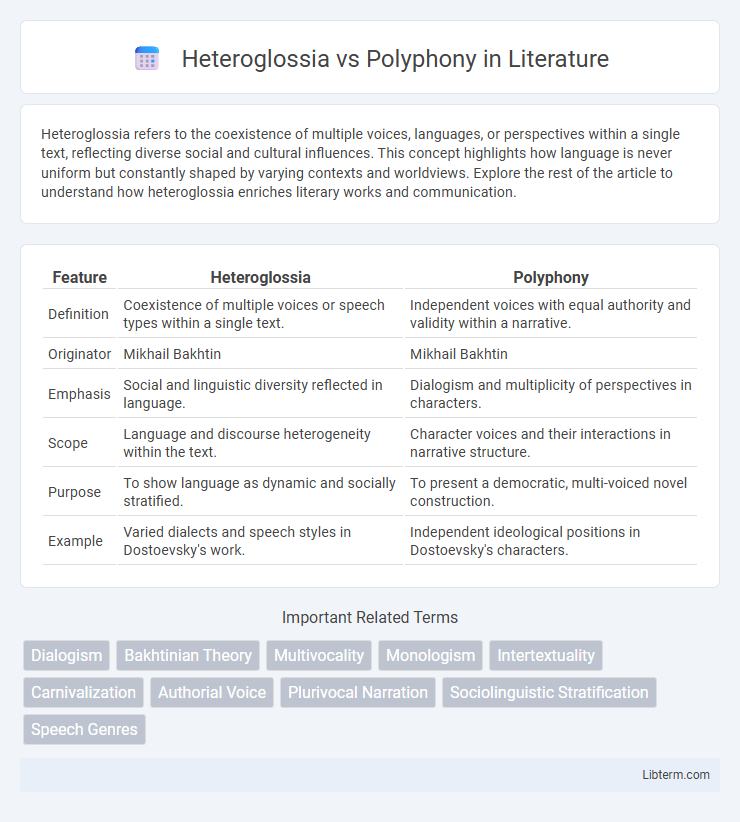Heteroglossia refers to the coexistence of multiple voices, languages, or perspectives within a single text, reflecting diverse social and cultural influences. This concept highlights how language is never uniform but constantly shaped by varying contexts and worldviews. Explore the rest of the article to understand how heteroglossia enriches literary works and communication.
Table of Comparison
| Feature | Heteroglossia | Polyphony |
|---|---|---|
| Definition | Coexistence of multiple voices or speech types within a single text. | Independent voices with equal authority and validity within a narrative. |
| Originator | Mikhail Bakhtin | Mikhail Bakhtin |
| Emphasis | Social and linguistic diversity reflected in language. | Dialogism and multiplicity of perspectives in characters. |
| Scope | Language and discourse heterogeneity within the text. | Character voices and their interactions in narrative structure. |
| Purpose | To show language as dynamic and socially stratified. | To present a democratic, multi-voiced novel construction. |
| Example | Varied dialects and speech styles in Dostoevsky's work. | Independent ideological positions in Dostoevsky's characters. |
Introduction to Heteroglossia and Polyphony
Heteroglossia, a concept developed by Mikhail Bakhtin, refers to the coexistence of multiple voices, styles, and meanings within a single text, reflecting diverse social languages and perspectives. Polyphony, also introduced by Bakhtin, describes a narrative structure where independent and equally authoritative voices interact without being subordinated to a dominant authorial perspective. Both concepts highlight the complexity of language and voice in literature, emphasizing diversity and dialogic interplay rather than a singular, authoritative discourse.
Defining Heteroglossia: Origins and Concepts
Heteroglossia, a concept developed by Mikhail Bakhtin, refers to the coexistence of multiple voices or languages within a single text, reflecting diverse social dialects, viewpoints, and ideologies. Unlike polyphony, which emphasizes the presence of independent and equally valid voices, heteroglossia highlights the dynamic interaction and tension between varied speech types embedded in cultural and historical contexts. This dialogic nature of heteroglossia reveals how language carries layered meanings shaped by social heterogeneity and power relations.
Understanding Polyphony: Literary Roots
Polyphony in literature, rooted in Mikhail Bakhtin's theories, emphasizes multiple independent voices within a text, each representing distinct social perspectives and ideological viewpoints. Unlike heteroglossia, which highlights the coexistence of diverse languages and dialects reflecting social stratification, polyphony centers on the dialogic interaction among autonomous voices that resist a singular authoritative narrative. This literary concept challenges monologic storytelling by allowing characters to express contradictions and conflicts, enriching narrative complexity and reader engagement.
Historical Context: Bakhtin’s Theories
Mikhail Bakhtin introduced heteroglossia to describe the coexistence of diverse voices and social languages within a single text, reflecting the historical and cultural stratification of language. Polyphony, as Bakhtin applied to Dostoevsky's novels, refers to multiple independent and unmerged voices, each with its own perspective and ideological stance, creating a dialogic relationship. These concepts are rooted in Bakhtin's critique of monologic and authoritative language, emphasizing the dynamic interaction of varied social discourses in literature's representation of reality.
Key Differences Between Heteroglossia and Polyphony
Heteroglossia refers to the coexistence of multiple voices, languages, and social dialects within a single text, emphasizing the diversity of speech types and ideological contradictions embedded in discourse. Polyphony, primarily associated with Bakhtin's novel theory, characterizes a narrative structure where multiple independent and unmerged voices or consciousnesses interact, each maintaining its own perspective and ideological position. The key difference lies in heteroglossia's focus on linguistically and socially stratified language diversity, while polyphony emphasizes the coexistence of fully autonomous voices that challenge the author's singular perspective.
Functions in Literary Texts
Heteroglossia refers to the coexistence of multiple voices and social languages within a single text, highlighting the diversity of perspectives and social contexts. Polyphony emphasizes the presence of distinct, independent voices that interact without merging into a single authoritative perspective, promoting dialogical tension. Both concepts function to enrich literary texts by representing complex social realities and challenging monologic interpretations.
Examples of Heteroglossia in Literature
Heteroglossia in literature is exemplified by Mikhail Bakhtin's analysis of Fyodor Dostoevsky's novels, where diverse social languages and ideological perspectives coexist within a single text, reflecting conflicting worldviews. In Charles Dickens' works, such as "Bleak House," multiple dialects and speech types represent various social classes, illustrating heteroglossic interactions. Similarly, Toni Morrison's "Beloved" uses heteroglossia through the interplay of African American vernacular and historical narratives, enriching the novel's thematic complexity.
Examples of Polyphony in Literature
Polyphony in literature refers to the presence of multiple, independent voices or perspectives within a text, as famously exemplified by Fyodor Dostoevsky's "The Brothers Karamazov," where conflicting ideologies and viewpoints coexist without authorial dominance. Mikhail Bakhtin's analysis highlights how polyphony creates a dialogic structure that allows characters to express autonomous consciousnesses, enriching narrative complexity. Other key examples include William Faulkner's "The Sound and the Fury," which employs distinct narrative voices to reflect fragmented subjectivities and diverse outlooks within a single story.
Impact on Narrative Voice and Structure
Heteroglossia introduces multiple social voices and distinct linguistic styles within a single narrative, enriching the narrative voice by reflecting diverse perspectives and social contexts. Polyphony emphasizes the coexistence of independent, equally valid voices that resist authorial dominance, creating a narrative structure characterized by dialogic interplay and complexity. Both concepts reshape traditional narrative voice and structure by fostering multiplicity and decentralization, enhancing thematic depth and realism.
Relevance in Contemporary Discourse
Heteroglossia and polyphony both emphasize the coexistence of multiple voices within a text, with heteroglossia highlighting the interaction of diverse social languages and polyphony showcasing independent, often conflicting, narrative perspectives. In contemporary discourse, heteroglossia is particularly relevant for analyzing how varying social, cultural, and ideological voices intersect and challenge dominant narratives in media and literature. Polyphony remains crucial for understanding character autonomy and the multiplicity of subjectivities, enriching interpretations of modern novels, films, and digital storytelling.
Heteroglossia Infographic

 libterm.com
libterm.com